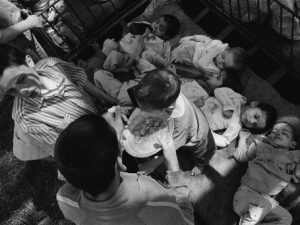By: Victoria Barker

News reports from this past year have been filled with the ongoing covert power struggle between the United States and Russia that has resulted in the use of children as political pawns in response to inconvenient legislation. Although rarely openly mentioned, this is not the first time children have been caught in the middle of government bureaucracy and red-tape, and it is unlikely that this will be the last time, unless advocating for children becomes the norm.
Russia’s response to the United States’ passage of The Magnitsky Act, which prevented Russian officials suspected of human rights abuses from entering the United States, resulted in a highly publicized ban on the adoption of Russian children by Americans. It is the most recent and probably the most well known example of this broken system. The ban is part of an ongoing diplomatic spat between the United States and Russia, which was initiated by the arrival of a 7-year-old adopted boy at a Moscow airport in 2010, who was sent back alone to Russia by his adoptive mother from Tennessee because of mental and behavioral problems. Recent controversial adoption scandals, such as the death of Max Shutto — an adopted
Russian boy who was living in Texas — have exacerbated the tension. Russia’s response has been often been referred to as a nationalistic campaign, which has the potential to lead to more Russians adopting more children. Proponents of this legislation argue that it will lead to the extension of Russian customs and traditions. Although nationalism and ethnic pride are certainly important, at some point the recognition of common humanity trumps that of their passport identity. In validating a common humanity there is an imperative need to provide for those who cannot provide for themselves.
With more than 153 million orphans in the world today, the duty to fulfill Article One of The Universal Declaration of Human Rights by “act[ing] towards one another in a spirit of brotherhood” should perhaps transcend governmental boundaries. In many ways, we have tried to do just that. In 2011, U.S. families adopted more than nine thousand children from around the world with the highest numbers coming from China, Ethiopia, and Russia. Since the fall of the Soviet Union, Americans have adopted more than 60,000 Russian children — more than that of any other country.
Although Chinese adoptions have been the most common, they cost between 20 and 40 thousand dollars and can take up to four and a half years. Other countries, such as Uganda have become a “quick and easy alternative for prospective parents” not seeking to navigate the messy bureaucratic process present in the former hotspots, such as China and Russia.
A recent CNN article detailed the ongoing adoption crisis in Uganda, where adoptions take merely a few months to complete largely because of the lack of the Hague Convention, which provides guidelines for “safe” international adoption. Here, the majority of young parents do not understand adoption when they are convinced to sign over their children to foreigners who can provide a better life for them. With more than seventy-seven percent of the Ugandan population under thirty years of age perhaps it is best for these children to be raised outside of the poverty and AIDS-stricken country that is home to parents who can barely survive. But, an even better alternative and one that would surely respond to the root of the issue rather than only worrying about the children that are currently affected, is to create systems in which parents are able to provide for their children, and the children have a quality of life that does not force them to be raised elsewhere. An adoption visa worker at the U.S. Embassy in Kampala, Uganda argues that, “the explosive growth of the adoption industry in Uganda has fueled fears that children are being exploited for profit and that the best interests of the child is not paramount”.
In the U.S. many people might advocate for citizens adopting domestically, but our system here can hardly be deemed better. With more than four hundred thousand U.S. children living in foster homes, in a system often stigmatized by the abuse-ridden and money-driven scandals that often appear in the headlines, our system does not provide a superior alternative. Each year twenty-seven thousand youth “age out” of the foster care system without the emotional and financial support necessary to succeed, and with statistics piled against them. 40 percent are homeless, only 48 percent of the men are employed, and 75 percent of the women and 33 percent of the men receive government benefits to meet their basic needs. These numbers present a strong case that the current foster care system is not creating the best futures.
Domestically, most adoptions take upwards of one year, but this is not the case for all domestic adoptions. Certain adoptions, particularly those involving children from group homes, are often times pushed through the system much quicker. Some suspect that this duration of time is too short, leading to placements that are fit for neither the children nor the parents. In some circumstances this results in adopted children being returned to the group homes or foster homes they had been transitioned from, thus repeating the cycle.
Currently, children’s homes across the country are attempting to address these problems. While orphanages seem to be a thing of the past in America, and something typifying rancid soviet institutions and overcrowded, dilapidated homes filled with malnourished children in Africa or Southeast Asia, they have existed in the U.S. since the beginning of our country. Now, they are few and far between and people are rarely cognizant of their existence. Many of these group homes have shifted to a family-style model, such as Thornwell Home for Children in South Carolina. This particular home provides 6-8 “orphans” with two sets of “parents” and attempts to emulate family living as close as possible. In most regards these homes are the best option for children that have had to face the consequences of low socio-economic statuses, abuse, and guardians who are unable to provide for them, yet these homes alone cannot break the cycle.
A new Thornwell initiative involves providing at-risk families with the in-home tools and educational training that they need to impede the brokenness and hopelessness that results from the admittance of the children into group homes. Perhaps, programs such as this are the alternative we should be looking toward. The cycle of orphans is multiplying worldwide and although adoption is one of the most selfless acts, it is possible that we have been focusing on the individual subject rather than also breaking the pattern.
If children are truly “our future” should we not be investing in them and providing them with families that can meet their needs, and urge them on toward bright futures rather than allowing them to be tied up in the red-tape that has come to exemplify the international and domestic bureaucratic processes? Is the goal to stall or to break the cycle? At what point do we need to shift from pulling individual children up from the cracks to understanding and reforming the circumstances that are leading to the creation of the cracks?

